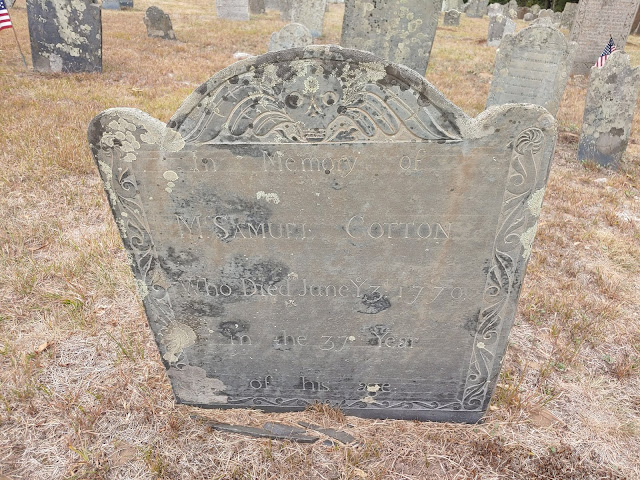Oftentimes the pinnacle of the Colonial American Tombstone stems from the slate markers produced in Boston during the 17th and 18th centuries. Most anyone who has studied American history from this period especially the Revolutionary War is familiar with the looming Winged Skulls and Winged Cherubim designs present in the major Boston Cemeteries (Kings Chapel Burying Ground, Granary, Cobbs Hill etc), even if one has never divulged into cemetery or grave-making studies as whole. Indeed long before I became interested in carvers, materials and the influences of different symbols I was enamored by the cemeteries I visited on a school trip to Boston in 5th grade and the often grim but elaborate symbolism. I quickly learned a few basic design principles such as the shift to neoclassical urn and willow designs from the Skull and soul effigies during the early 1800's and learned of brownstone once I had returned home. My learning never stemmed beyond basic design tropes though I would often go out of my way to visit the burying grounds in my area. As I returned to my interest in Cemeteries and tombstones, I remember visiting a cemetery in Woodstock when I was much younger and remember being confused as to seeing skull slates, which were rare in most yards in the region. After revisiting last year I saw over 30 skull slates and numerous other Boston region stones.
 |
| Stone dated 1704 carved by William Mumford. Note the family Coat of Arms, sometimes present on tombstones especially for first generation English immigrants during this period. |
During the colonial period, Boston was a mecca for grave-carving. As Boston's population grew rapidly during the mid 1600s, a full time grave carver was needed for the rapidly expanding (and dying) populous. The first full time carver in the region is unknown and is often referred to as the "Old Master" "The Charlestown Stonecutter" and "The Old Stone Carver" among other names. Though his identity is unknown, he was confirmed to have carved from the mid 1650s until the turn of the century and taught then apprentice Joseph Lamson who would also become a prominent carver, and start a family carving business that would last 5 generations.
By the turn of the century, carvers like Joseph Lamson, William Mumford, James Foster Sr. and of course the "Old Master" were established in not only the entire Middlesex county region, but were exporting stones all over the state and to many cemeteries in Rhode Island, Connecticut, Maine, and other north Atlantic states. As more and more demand increased, more Bostonians entered the grave carving business, apprenticing with experienced carvers, and opening new shops. By the 1720's stones from Boston were being exported in large numbers as far south as Charleston South Carolina and as far north as New Brunswick and Nova Scotia. Boston slate was prized for its durability and beauty, so sometimes carvers in other regions would purchase raw material for their own stonecutting. Boston carved tombstones were usually very elaborate and featured ornate designs and borders, as well as different shades of slate for all tastes.
 |
| Boston Skull slate dated 1751 in the Woodstock Hill Burying ground. |
As is expected, the majority of Boston slates in Connecticut are found in coastal regions, reasoning being these stones would be imported by ship and the cost would increase sufficiently considering a 30 mile trip from the New London port to Windham on a horse drawn wagon would take around 9 hours in those days. However a large concentration of Boston carved stones were placed in Woodstock and Pomfret. A small number of Boston slates are scattered around some other burying grounds in eastern CT, but the vast majority are either in coastal towns or the extreme northeastern region.
Both Woodstock and Pomfret Connecticut had a large number of founders from eastern Mass, particularly the Roxbury region and due to this cultural background, many stones from the Boston were imported here. During the colonial period Pomfret was considered a high class town by many and often the Wealthy and Famous of Boston and elsewhere would attend balls and other social events held in the area.
The Sabin Burying ground (also known as South Cemetery or Old Pomfret Burying Ground) has a large number of Boston slates. Though regional carvers including the Kimballs, Elijah Sikes, and David Lamb are still well represented here, over 80 imported Boston slates (not including urn and willow style) can be seen here, most being skull designs. The imported slates range in dates from the 1730s until the 1840s, well after the soul/skull effigy's were replaced by urn designs.
| Stone carved by James II Foster of Dorchester Mass, dated 1744. Foster II often used borders that resembled unfurled scrolls, and the wings had a slight curve underneath with a sharpe downward overall curve. |
Stone carved by either James Foster II or his son James Foster III of Dorchester Mass dated 1778. Foster III only carved Soul Effigies while his father carved both designs. |
Woodstock also had a deep connection to Eastern Massachusetts, as it was founded by 13 people from Roxbury mass in 1682. The settlement was originally named "New Roxbury" and was actually a part of the Massachusetts Bay Colony until borders changed in 1749, where it became part of the Connecticut River Colony. Though all the Colonial Cemeteries in Woodstock have a significant number of Boston tombstones, I have only visited the Woodstock Hill Burying Ground and can only show those photos.
 |
A skull slate dated 1745 carved by James Foster II. |


















No comments:
Post a Comment